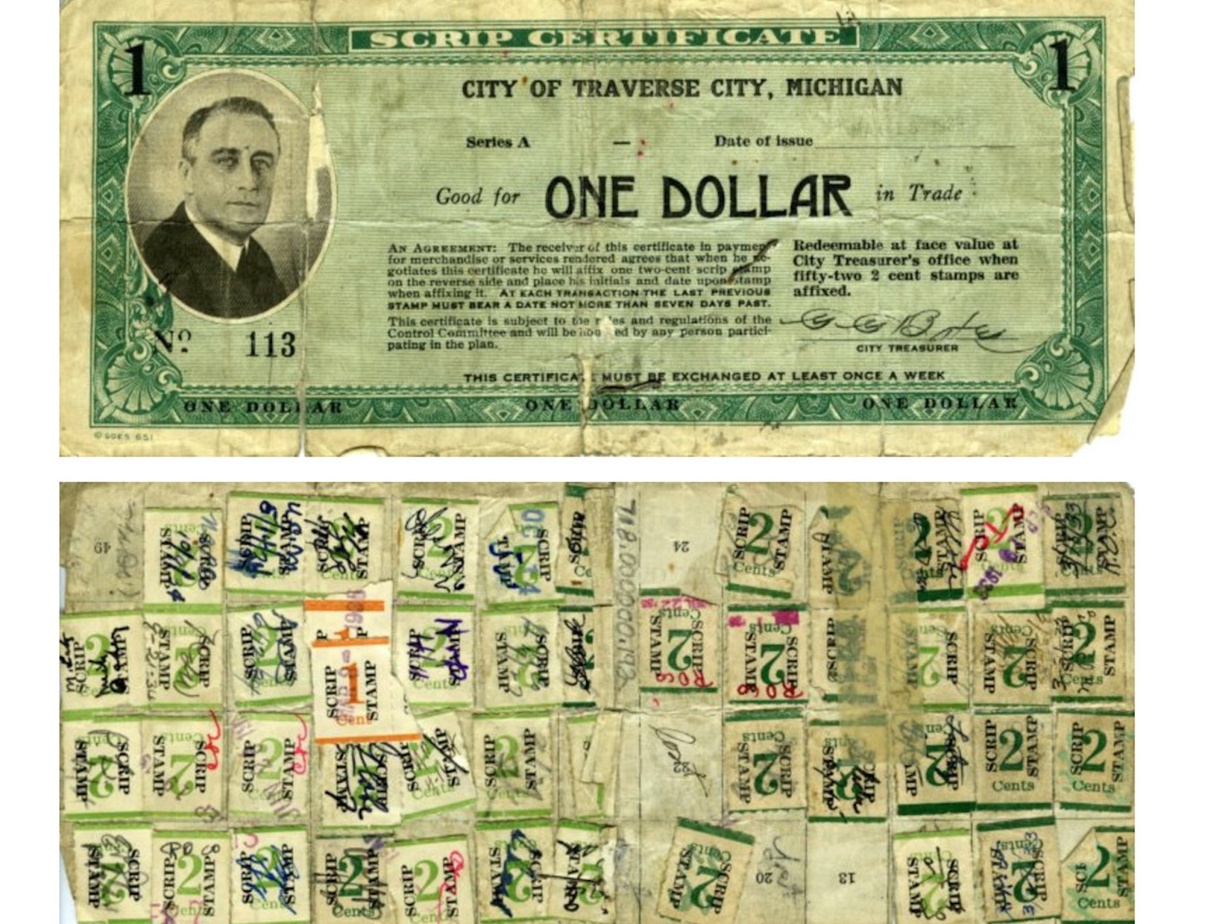
When Northern Michigan Bought Things With Traverse Dollars
By Ross Boissoneau | May 24, 2020
During the Great Depression, some banks were closing temporarily and others failing completely. There was little money in the hands of the people, and given the uncertainty about their prospects of getting more of it, people tended to hoard what little they had. The short supply of U.S. dollars in the 1930s meant there was a need to come up with another way for trade to keep the economy going -- leading to the idea of local currencies, known across the country as Depression scrip.
In effect, it was a local bartering system, easier than exchanging goods or services, and used across a broad base of stores and services. And here this region, residents traded Traverse Dollars.
Local historian Richard Fidler notes the use of scrip was encouraged by no less than President Franklin Roosevelt. “The purpose was to get people spending again, not just hide money under the mattress,” he says.
Fidler explains they were issued in 1934 and could be redeemed at many Traverse City businesses in exchange for goods. At one point, local teachers were even paid in scrip, since there was no other money available for them.
So what were the stamps all over the backs of Traverse Dollars for?
According to DepressionScrip.com, the fact that there was little money in the hands of the people and there was great uncertainty about the prospects of getting more of it, people tended to hoard whatever money they did have. So to ensure wide distribution and use, the dollars had to be used on a weekly basis or they would lose value.
So the stamps were a way to make sure the Traverse Dollars were circulated. According to Cathy Schmitt, who first brought them to The Ticker’s attention, the money would decay by two cents a day unless you put a two-cent stamp on it and signed and dated it. So the incentive was to spend as fast as you could, she says.
Merchants bought the stamps from the city treasurer, then attached them to the Traverse Dollars when consumers used them. “Every merchant supplied a stamp and after twenty stamps, the scrip could be turned in for a real dollar,” Fidler notes. The system seemed to work fairly well, though apparently there were some problems with the stamps falling off.
There are sound arguments for creating and using a local currency. By its very nature, local money tends to stay close to home. Traverse Dollars could not be used elsewhere, meaning local stores and merchants would be the ones to benefiting.
So profits cannot be sent outside the local community elsewhere through franchises or national chains. According to the Center for New Economics, “Regional currencies represent a democratization … supporting local businesses and educating consumers about how their money circulates in the local economy. These currencies serve as tools to keep local money local.”
Which brings us to the descendant of Traverse Dollars: In 2003, a group of community activists decided to revisit the idea. When Bay Bucks debuted in 2005, a number of businesses and individuals signed on to be part of the program. For many, it was an opportunity take back control. Brad Kik, an early member of the Bay Bucks Board and co-founder of Crosshatch Center for Art & Ecology in Bellaire, previously told The Ticker that U.S. currency was tied to conflict and war, as well as wealth inequality. Many of the early adapters were entrepreneurs who felt much the same way.
Over the years the concept slowly lost momentum, leading to just a very few businesses still utilizing Bay Bucks. The foremost is Oryana, which both accepts them and pays local vendors and suppliers in part with them and uses them for stipends for board members.
While Traverse Dollars may be a relic of the past, there is a possibility there could be new life ahead for Bay Bucks in a digital format. The Bay Bucks Board hosted a public forum a year ago to discuss how such a concept could work. Organizers suggested that it could be particularly relevant for that portion of consumers which eschews paper currency in favor of credit cards, Apple Pay or other cash alternatives.
Kik says the meeting centered around the use of Common Good, a platform for digital currency. But as those interested in the idea are all working on a number of other projects, it has not yet been pursued further. He is hopeful that the idea is not dead, but merely stalled.







